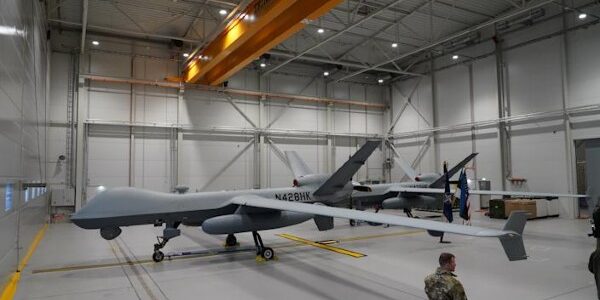
The Biden administration has disclosed a set of rules secretly issued by President Donald Trump in 2017 for counterterrorism “direct action” operations — like drone strikes and commando raids outside conventional war zones — which the White House has suspended as it weighs whether and how to tighten the guidelines.
While the Biden administration censored some passages, the visible portions show that in the Trump era, commanders in the field were given latitude to make decisions about attacks so long as they fit within broad sets of “operating principles,” including that there should be “near certainty” that civilians “will not be injured or killed in the course of operations.”

At the same time, however, the Trump-era rules were flexible about permitting exceptions to that and other standards, saying that “variations” could be made “where necessary” so long as certain bureaucratic procedures were followed in approving them.
Sign up for The Morning newsletter from the New York Times

In October, Judge Edgardo Ramos of the Southern District of New York had ordered the government turn over the 11-page document in response to Freedom of Information Act lawsuits filed by The New York Times and by the American Civil Liberties Union. The Biden administration inherited that case and sought a delay but has now complied, providing a copy to both plaintiffs late Friday.
The Biden administration suspended the Trump-era rules on its first day in office and imposed an interim policy of requiring White House approval for proposed strikes outside of the war zones of Afghanistan, Iraq and Syria. At the same time, the Biden team began a review of how both Obama- and Trump-era policies had worked — both on paper and in practice — with an eye toward developing its own policy.
The review, officials said, discovered that Trump-era principles to govern strikes in certain countries often made an exception to the requirement of “near certainty” that there would be no civilian casualties. While it kept that rule for women and children, it permitted a lower standard of merely “reasonable certainty” when it came to civilian adult men.
Emily Horne, a spokesperson for the National Security Council, declined to comment on the Trump-era rules.
“We’ll let the previous administration speak to their policies,” she said.
Brett Max Kaufman, a senior staff lawyer with the ACLU’s Center for Democracy, portrayed the Trump-era rules as having “stripped down even the minimal safeguards President Obama established in his rules for lethal strikes outside recognized conflicts” and called on President Joe Biden to end “secretive and unaccountable use of lethal force.”
But Thomas P. Bossert, who helped oversee interagency development of the Trump-era rules in 2017 when he was a top counterterrorism adviser to Trump, said he was proud of them and argued that the policy “should not be dismissed or replaced without careful consideration and an examination of the results it produced.”
“I stand by the policies I helped produce,” Bossert said. “They were informed by American values, the principles of the laws of armed conflict, and tailored to combat the real and present threat to America and her allies.”
The Biden review and deliberations over a potential new direct-action policy were initially expected to last 60 days, according to officials familiar with internal deliberations. But officials are now talking about extending them to six months, they said.
The policy discussions, they said, were slowed by an effort to obtain reliable comparative data about civilian casualties from past strikes — and disputes over whether the military’s estimates were accurate. Claims of civilian casualties are often murky from strikes in remote and inaccessible regions.
The deliberations have also been complicated by Biden’s decision to end the Afghanistan War by the 20th anniversary of the Sept. 11 attacks this year. The administration intends to maintain an ability to strike at any emerging terrorism threats that may subsequently emanate from there, which will make it subject for the first time to the rules for airstrikes, including by drones, outside conventional war zones.
It is not yet clear where in the region assets like drones will be based after the pullout from Afghanistan, which in turn affects how long surveillance craft will be available to hover over potential strike zones to watch who comes and goes before an attack. As a result, the question of whether to tighten the requirement of “near certainty” that no civilians will be killed so that it always protects adult men has become intertwined with other complex and unresolved policy decisions.
Targeted killings away from conventional war zones have become a central feature of the sprawling war that began with the Sept. 11 attacks, raising legal and policy questions that remain in flux, even as the threat from al-Qaida and its splintering progeny morphs and evolves as well.
Such intermittent combat activity has been driven by the emergence of armed drone technology and the propensity of transnational terrorist groups to operate from poorly governed spaces or failed states where there are few or no U.S. troops on the ground, but also no effective local government with a police force, including the tribal region of Pakistan, rural Yemen and portions of Somalia and Libya.
Drone strikes began under the administration of George W. Bush and soared during Barack Obama’s first term — along with political and legal battles over reports of civilian casualties and, in 2011, the government’s deliberate killing of a U.S. citizen suspected of terrorism, Anwar al-Awlaki, without a trial.
In May 2013, Obama imposed a set of rules intended to govern such operations and constrain their excessive use. It required a high-level, interagency review of whether a terrorism suspect posed a threat to Americans, as well as “near certainty” that no civilian bystanders would be killed.
In October 2017, Trump replaced Obama’s system with a more relaxed and decentralized system. It permitted operators in the field to decide whether to target suspects based on their status as members of a terrorist group, rather than based on their threats as individuals, and so long as conditions laid out in the general operating principles for that area had been met.
Many Obama-era national security officials have returned in the Biden administration, raising expectations that Trump’s changes would be at least partly rolled back. Still, some military and intelligence professionals chafed under Obama’s system, saying it was too bureaucratic, according to people familiar with internal deliberations.
The Trump administration did not make public that it had developed a new framework for drone strikes in 2017, although the Times reported on its existence and some of its key features at the time. Bossert said he had unsuccessfully pushed then to declassify and make public its key parts.
“I suggested relevant parts of the policy be declassified — from the outset,” he said. “My suggestion was not followed. Nevertheless, this debate and our core principles of valuing innocent life, while taking only the most evil, should always be open to the light of day.”
Credit: Yahoo News
